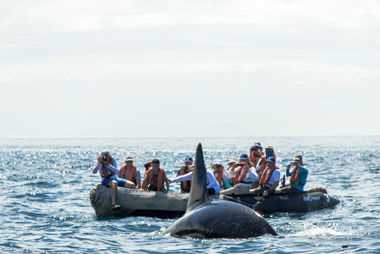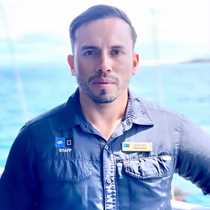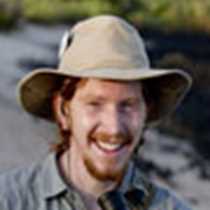Isabela is the largest island of them all, holding more than half of the land mass in Galapagos on its surface. This island is shaped like a sea horse and it contains one of the wildest ecosystems on the planet, from 500 pound tortoises to pink iguanas that live on top of active volcanoes.
We were aware of how unique this corner of the Galapagos is, therefore we woke up early in the morning to take advantage of the first glimpse of light. As we sailed, we watched all of the breathtaking landscapes full of titan volcanoes, pelagic sea birds, and a whale in the distance that showed up for a couple of seconds, then disappeared.
After breakfast we crossed the equator line and we arrived at the southern hemisphere. As we were getting ready to go on a Zodiac ride a couple of Orcas were spotted in the distance and we got in the Zodiacs and took off to find them in the wild.
Two male Orcas were spotted right next to our Zodiacs, one adult male and a younger male were feeding on the Pacific green sea turtles that rest within this calm cove of Isabela, known as Punta Vicente Roca. Orcas are rare transients of the Galapagos and for us to have both of them right next to our Zodiac, breaking one green Pacific sea turtle apart, as the frigates were picking up the leftovers was just an absolutely incredible show, and we were almost in tears to have the best seat in the house to watch. What an incredible morning! It truly doesn’t get better than this. WATCH THE ENCOUNTER HERE.
After a spectacular Zodiac ride we went snorkeling with Pacific green sea turtles, flightless cormorants, Galapagos penguins, and some playful Galapagos sea lions.
After lunch we disembarked on the youngest of the Galapagos Islands, known as Fernandina. It is a place like no other since it makes you feel like you’re traveling back in time, where you can have a sense of how every island in the Galapagos was in the beginning of time, before they had a complex ecosystem established on them. This is the youngest island of them all. Located at the western most point in Galapagos, it gets bathed by all the cold water which is rich in nutrients from the Cromwell current. Species are having a feast in the ocean here. We spotted Galapagos penguins fishing along the coast, flightless cormorants resting on the lava fields, and some of the largest colonies of marine iguanas basking in the sun. The landscape here is a bit barren, yet it’s full of life everywhere you look. We finished our day astonished by all the beauty we experience in this place.
Galapagos Islands truly changed the world, and even better, they can change the perspective of how we humans see the world.









